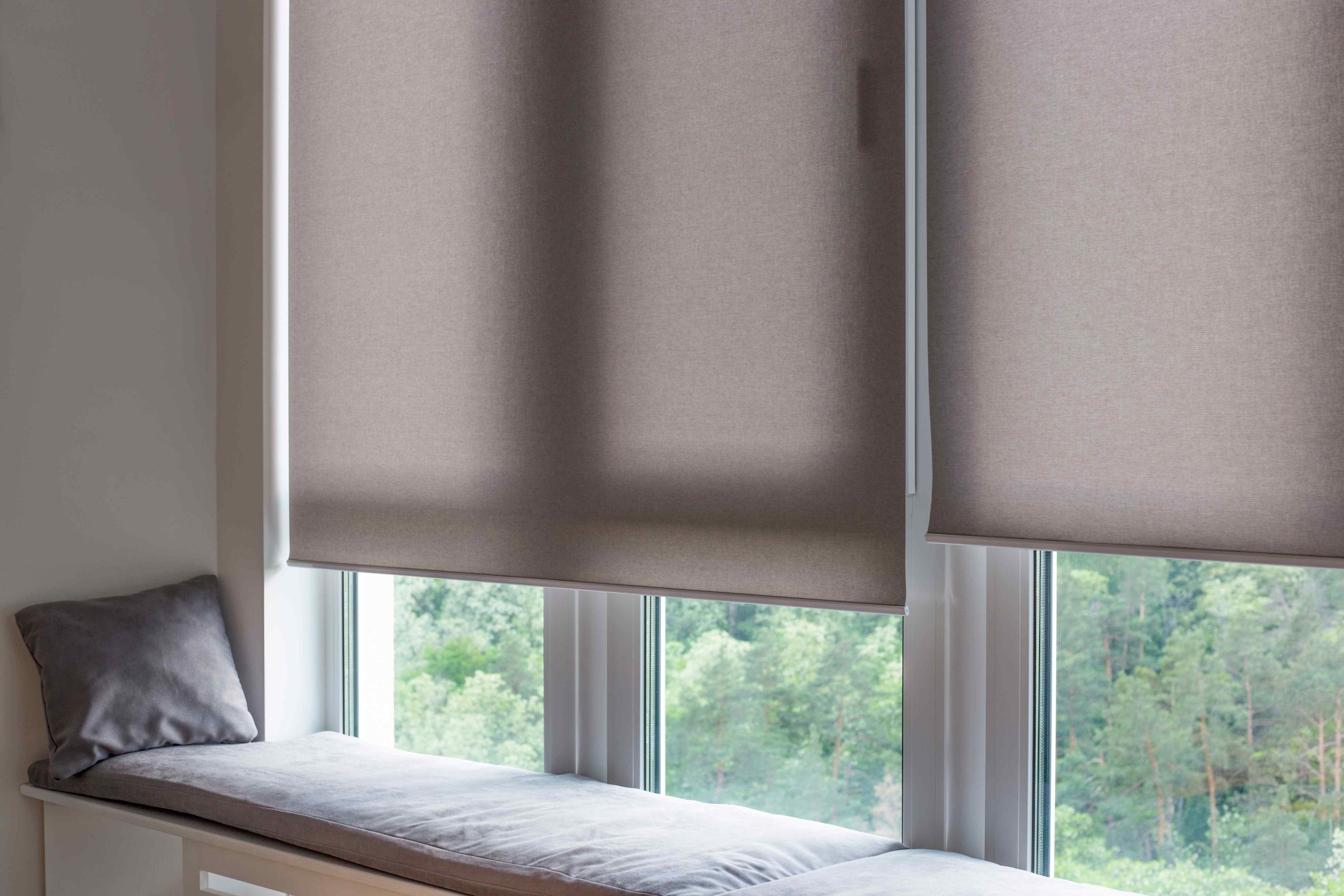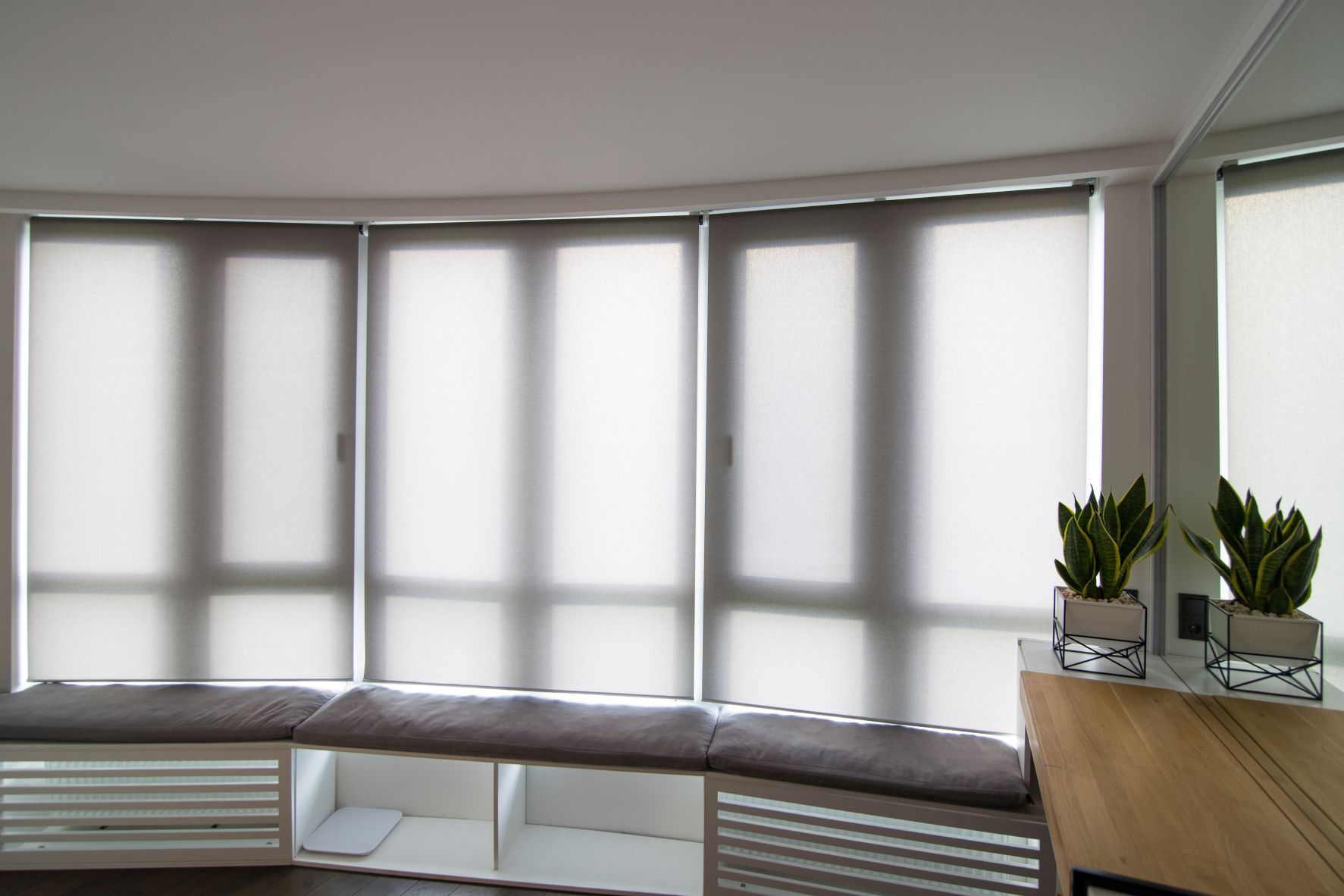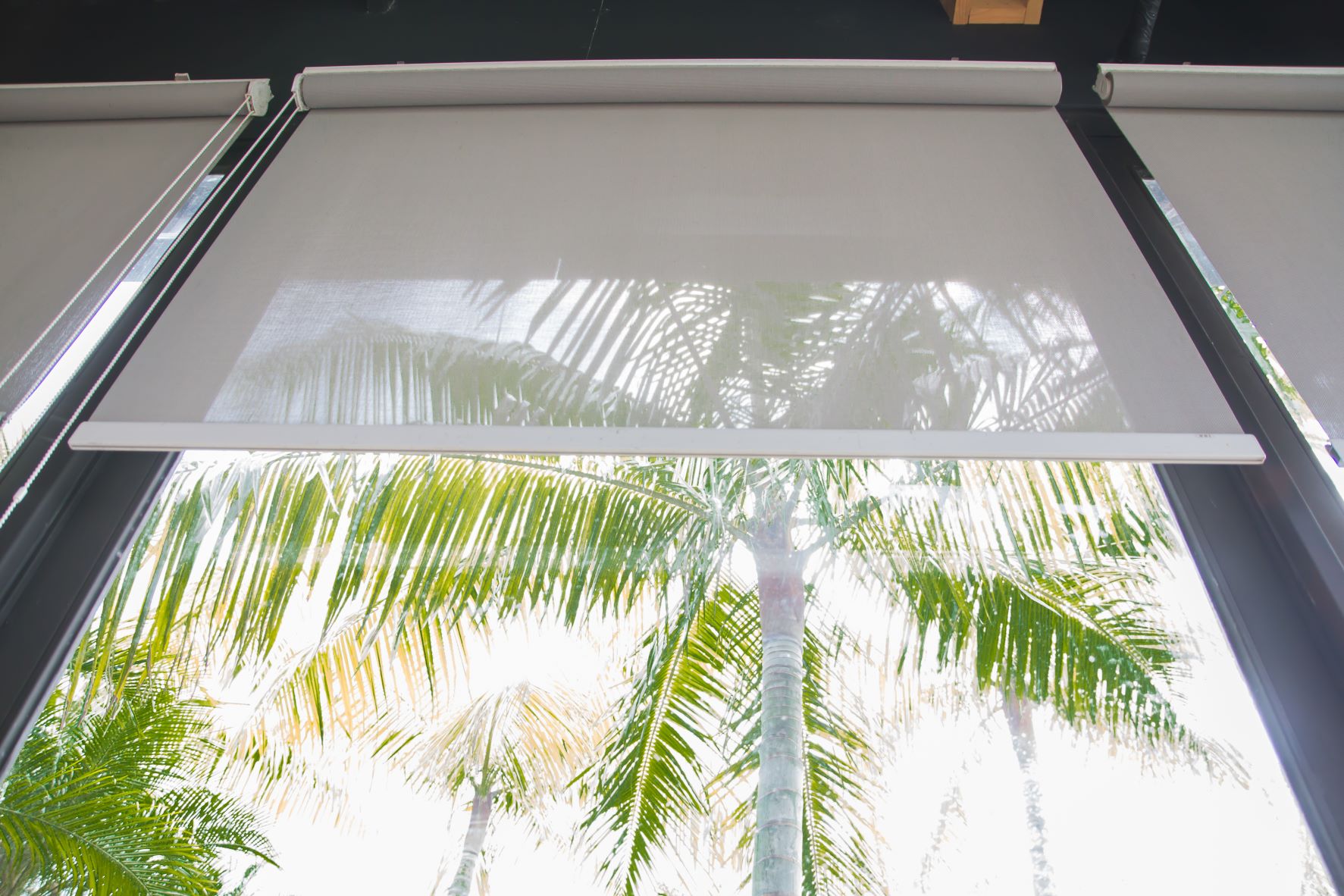
To the untrained eye, roller shades and solar shades may not seem that different. After all, both cover a window in a single, simple sheet of material and operate with a roller and tube function, so many people assume they are different, interchangeable names for the same thing. In truth, solar shades are a type of roller shade, but not all roller shades are solar shades, and each has distinct uses and benefits. The experts at Bloomin' Blinds can help you understand the difference.
The main difference between solar shades and roller shades is the material used. Solar shades are made from a screen-like mesh material designed to block UV rays without entirely blocking the view, while roller shades can be made from a range of textiles, often vinyl or fabric, with the purpose of controlling the light in a room. Roller shades are often used to darken or black out a room, while solar shades only control UV rays and can sometimes be found as exterior shades. Let's take a closer look at their unique features and functions.

Solar shades are a type of roller shade that is specially designed to provide light control and protect against UV rays. They come in various ranges of "openness", which determines how much light is let in. They enable you to decide how much light you want to let into your home while still allowing you some transparency to view what's outdoors.
Solar shades cover a window in a single layer of woven, screen-like material using a roller and tube mechanism to open and close. Some solar shades have looped lift chains or cords, while some are cordless and operate with a gentle tug, like a projector screen. The primary function of a solar shade is to filter and block harsh UVA and UVB rays from entering your home. Ultimately, this helps to regulate the temperature in your home, save energy, and protect floors, furniture, and art from fading.
The important thing to look for when shopping for solar shades is the "openness." This measurement refers to the tightness of the weave and the amount of UV rays that make it through. For instance, if a solar shade is labeled as 7 percent openness means that the shade blocks 93 percent of UV rays and lets in 7%. The openness on solar shades commonly ranges from 1 to 14 percent.
Solar shades are typically only available in neutral colors. Because their main function of blocking UV rays relies on the woven mesh, there isn't a lot of variety in color. However, whether you choose light fabric or dark fabric can make a difference and produce different results, so it's important to keep this in mind.
Lighter colored fabrics are better at reflecting heat and keeping a room cooler, as well as brightening a room. However, because of this brightening effect, light-colored solar shades tend to obscure the view or create a cloudy look. Darker colored solar shades, on the other hand, absorb glare and can provide a clearer view. Because they aren't as effective at reflecting the sun's rays, you may need a lower openness (i.e. a tighter weave) in a darker color to get the same temperature regulation as a lighter colored solar shade.
One drawback to solar shades is a lack of privacy at night. During the day, solar shades block UV rays while preserving the view from indoors to the outside world. When the sun is out, solar shades often appear opaque from the outside, so some people forget the opposite is true at night. When it's dark outside and the lights are on in the house, passersby have a clear view of what's going on inside. This makes solar shades ideal for windows that don't face the street or neighboring houses, unless they're used as a foundational window treatment under curtains or other drapery.

Broadly speaking, a roller shade is a type of window covering made of a solid piece of material that rolls up around a tube at the top and is controlled by a continuous-loop lift cord or chain or a spring mechanism. Roller shades are often used to completely block all light from entering a room-which is particularly useful in rooms like bedrooms and home theaters-but are available in many opacities ranging from sheer to light-filtering to room-darkening and blackout.
View our Roller Shades Photo Gallery!
Roller shades are always a simple, classic, budget-friendly option. They offer clean lines, easy operation, and a variety of customization choices. Sometimes overlooked as "boring," a roller blind can deliver incredibly stylish function to your windows, either on their own or as a foundational piece under drapery or curtains.
When considering roller shades, keep in mind that they are available in a wide range of colors, patterns, textures, materials, and opacities. There are also a few different operation options, including continuous-loop lift cords, spring mechanisms, or motorization. Bloomin' Blinds also offers decorative touches, such as matching cassette header to hide the roller and create a finished look. Contact us today to request a free consultation and learn more about your options!

About the Author: Kris Stuart, Bloomin' Blinds
Kris has been a window covering expert in the industry since 2001. He has expertise in a wide range of window covering matters, including repairs, installations, sales, and administration. In his free time, Kris loves to spend time with his wife and kids, making them laugh, travel together, and trying new hobbies.
Warranty Info: All products offered by Bloomin’ Blinds are covered by a limited lifetime warranty for the original purchaser. The warranty protects against the following items: Warping, discoloration, manufacturer material defects and install issues. In the event of a warranty need, there will be no cost to the homeowner and Bloomin’ Blinds will service the repair at your home/office whenever possible. *** Warranty specifics varies by location, please contact for more information.
We are currently looking to expand our business in the territories listed below.
We are always looking to grow! If your preferred location is not listed, feel free to leave a note upon filling out the contact form!
Contact UsWe are currently looking to expand our business in the territories listed below.
We are always looking to grow! If your preferred location is not listed, feel free to leave a note upon filling out the contact form!
Contact UsWe currently have no opportunities available in the entire state of West Virginia.
We are always looking to grow! If your preferred location is not listed, feel free to leave a note upon filling out the contact form!
Contact UsWe are currently looking to expand our business in the territories listed below.
We are always looking to grow! If your preferred location is not listed, feel free to leave a note upon filling out the contact form!
Contact UsWe are currently looking to expand our business in the territories listed below.
We are always looking to grow! If your preferred location is not listed, feel free to leave a note upon filling out the contact form!
Contact UsWe are currently looking to expand our business in the territories listed below.
We are always looking to grow! If your preferred location is not listed, feel free to leave a note upon filling out the contact form!
Contact UsWe are currently looking to expand our business in the territories listed below.
We are always looking to grow! If your preferred location is not listed, feel free to leave a note upon filling out the contact form!
Contact UsWe are currently looking to expand our business in the territories listed below.
We are always looking to grow! If your preferred location is not listed, feel free to leave a note upon filling out the contact form!
Contact UsWe are currently looking to expand our business in the territories listed below.
We are always looking to grow! If your preferred location is not listed, feel free to leave a note upon filling out the contact form!
Contact UsWe currently have no opportunities available in the entire state of South Dakota.
We are always looking to grow! If your preferred location is not listed, feel free to leave a note upon filling out the contact form!
Contact UsWe are currently looking to expand our business in the territories listed below.
We are always looking to grow! If your preferred location is not listed, feel free to leave a note upon filling out the contact form!
Contact UsWe are currently looking to expand our business in the territories listed below.
We are always looking to grow! If your preferred location is not listed, feel free to leave a note upon filling out the contact form!
Contact UsWe are currently looking to expand our business in the territories listed below.
We are always looking to grow! If your preferred location is not listed, feel free to leave a note upon filling out the contact form!
Contact UsWe are currently looking to expand our business in the territories listed below.
We are always looking to grow! If your preferred location is not listed, feel free to leave a note upon filling out the contact form!
Contact UsWe are currently looking to expand our business in the territories listed below.
We are always looking to grow! If your preferred location is not listed, feel free to leave a note upon filling out the contact form!
Contact UsWe are currently looking to expand our business in the territories listed below.
We are always looking to grow! If your preferred location is not listed, feel free to leave a note upon filling out the contact form!
Contact UsWe currently have no opportunities available in the entire state of North Dakota.
We are always looking to grow! If your preferred location is not listed, feel free to leave a note upon filling out the contact form!
Contact UsWe are currently looking to expand our business in the territories listed below.
We are always looking to grow! If your preferred location is not listed, feel free to leave a note upon filling out the contact form!
Contact UsWe are currently looking to expand our business in the territories listed below.
We are always looking to grow! If your preferred location is not listed, feel free to leave a note upon filling out the contact form!
Contact UsWe are currently looking to expand our business in the territories listed below.
We are always looking to grow! If your preferred location is not listed, feel free to leave a note upon filling out the contact form!
Contact UsWe are currently looking to expand our business in the territories listed below.
We are always looking to grow! If your preferred location is not listed, feel free to leave a note upon filling out the contact form!
Contact UsWe currently have no opportunities available in the entire state of New Hampshire.
We are always looking to grow! If your preferred location is not listed, feel free to leave a note upon filling out the contact form!
Contact UsWe are currently looking to expand our business in the territories listed below.
We are always looking to grow! If your preferred location is not listed, feel free to leave a note upon filling out the contact form!
Contact UsWe currently have no opportunities available in the entire state of Nebraska.
We are always looking to grow! If your preferred location is not listed, feel free to leave a note upon filling out the contact form!
Contact UsWe are currently looking to expand our business in the territories listed below.
We are always looking to grow! If your preferred location is not listed, feel free to leave a note upon filling out the contact form!
Contact UsWe are currently looking to expand our business in the territories listed below.
We are always looking to grow! If your preferred location is not listed, feel free to leave a note upon filling out the contact form!
Contact UsWe are currently looking to expand our business in the territories listed below.
We are always looking to grow! If your preferred location is not listed, feel free to leave a note upon filling out the contact form!
Contact UsWe are currently looking to expand our business in the territories listed below.
We are always looking to grow! If your preferred location is not listed, feel free to leave a note upon filling out the contact form!
Contact UsWe are currently looking to expand our business in the territories listed below.
We are always looking to grow! If your preferred location is not listed, feel free to leave a note upon filling out the contact form!
Contact UsWe are currently looking to expand our business in the territories listed below.
We are always looking to grow! If your preferred location is not listed, feel free to leave a note upon filling out the contact form!
Contact UsWe are currently looking to expand our business in the territories listed below.
We are always looking to grow! If your preferred location is not listed, feel free to leave a note upon filling out the contact form!
Contact UsWe are currently looking to expand our business in the territories listed below.
We are always looking to grow! If your preferred location is not listed, feel free to leave a note upon filling out the contact form!
Contact UsWe are currently looking to expand our business in the territories listed below.
We are always looking to grow! If your preferred location is not listed, feel free to leave a note upon filling out the contact form!
Contact UsWe are currently looking to expand our business in the territories listed below.
We are always looking to grow! If your preferred location is not listed, feel free to leave a note upon filling out the contact form!
Contact UsWe are currently looking to expand our business in the territories listed below.
We are always looking to grow! If your preferred location is not listed, feel free to leave a note upon filling out the contact form!
Contact UsWe are currently looking to expand our business in the territories listed below.
We are always looking to grow! If your preferred location is not listed, feel free to leave a note upon filling out the contact form!
Contact UsWe are currently looking to expand our business in the territories listed below.
We are always looking to grow! If your preferred location is not listed, feel free to leave a note upon filling out the contact form!
Contact UsWe are currently looking to expand our business in the territories listed below.
We are always looking to grow! If your preferred location is not listed, feel free to leave a note upon filling out the contact form!
Contact UsWe are currently looking to expand our business in the territories listed below.
We are always looking to grow! If your preferred location is not listed, feel free to leave a note upon filling out the contact form!
Contact UsWe currently have no opportunities available in the entire state of Hawaii.
We are always looking to grow! If your preferred location is not listed, feel free to leave a note upon filling out the contact form!
Contact UsWe are currently looking to expand our business in the territories listed below.
We are always looking to grow! If your preferred location is not listed, feel free to leave a note upon filling out the contact form!
Contact UsWe are currently looking to expand our business in the territories listed below.
We are always looking to grow! If your preferred location is not listed, feel free to leave a note upon filling out the contact form!
Contact UsWe currently have no opportunities available in the entire state of Delaware.
We are always looking to grow! If your preferred location is not listed, feel free to leave a note upon filling out the contact form!
Contact UsWe are currently looking to expand our business in the territories listed below.
We are always looking to grow! If your preferred location is not listed, feel free to leave a note upon filling out the contact form!
Contact UsWe currently have no opportunities available in the entire state of Colorado.
We are always looking to grow! If your preferred location is not listed, feel free to leave a note upon filling out the contact form!
Contact UsWe are currently looking to expand our business in the territories listed below.
We are always looking to grow! If your preferred location is not listed, feel free to leave a note upon filling out the contact form!
Contact UsWe are currently looking to expand our business in the territories listed below.
We are always looking to grow! If your preferred location is not listed, feel free to leave a note upon filling out the contact form!
Contact UsWe are currently looking to expand our business in the territories listed below.
We are always looking to grow! If your preferred location is not listed, feel free to leave a note upon filling out the contact form!
Contact UsWe currently have no opportunities available in the entire state of Alaska.
We are always looking to grow! If your preferred location is not listed, feel free to leave a note upon filling out the contact form!
Contact UsWe are currently looking to expand our business in the territories listed below.
We are always looking to grow! If your preferred location is not listed, feel free to leave a note upon filling out the contact form!
Contact Us